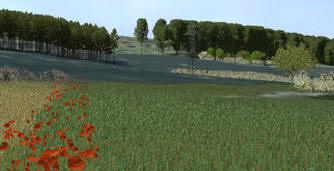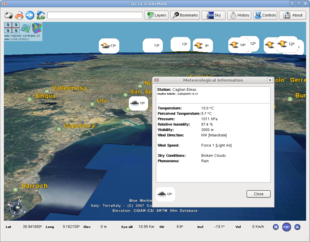Government / Academic
Terrain Tools and Research Projects
- EarthSLOT - Science,
Logistics, and Outreach Terrainbases
- A collection of pointers to scientific visualizations on 3D terrain
which are built on top of a variety of earth viewing software,
including: Google Earth, Skyline TerraExplorer, WorldWind, and
GeoFusion. They refer to these visualization as "applications",
although they are more generally datasets.
- Their mission is "to
advance earth science and earth science education through the use of
on-line 3D terrain visualization and GIS tools."
- Includes some
interesting datasets
in Alaska, the Arctic and Antarctic, with an emphasis on geologic
features including hurricanes, earthquakes and glaciers worldwide.
- Terrain
Visualization
at the CRS4 Visual Computing Group
- Infinite Universe Engine - IUE
- Infinite Universe Engine is an impressive GPL-licensed renderer of
the entire solar system
- by Jochen Winzen at the University of Karlsruhe, 2003
- it does not have a website of its own, so i have created a page
for it here on the VTP site
-
 LandView Terrain Viewer
LandView Terrain Viewer
- A set of 3D software and map/image files from the
U.S. EPA that let you fly over a
representation of real areas in the United States, and in doing so, to
view the location of EPA-regulated sites, as well as population
statistics for any radius.
- The viewer is free and Windows-only.
- built on the
ChunkLOD
library (see LOD
implementations) for support of very large datasets: each city model
is around 125-300 MB in size.
- Though the terrain viewer is still in beta, many areas already
available (Boston, Baltimore, New York City, Reston VA, Seattle, St.
Louis, Tulsa OK, Maine, Richmond VA)
- Lenné3D

- A 3-year German project started May 2002 at
ZALF, for research in computer
graphics, landscape modeling and visualization.
- The project developed a system for interactive 3D landscape
visualization both from map view and from stroller’s view. The 3D
visualization system is supposed to support the dialogue on community
landscape planning and decision-making. As an interdisciplinary project,
it focuses on visualization of vegetation and GIS data as well as
interactive exploration and editing of spatial data.
- Many of the resulting papers are published in
Trends in
Real-Time Landscape Visualization and Participation, Proceedings at
Anhalt University of Applied Sciences 2005
- The Lenné3D project was (2005) spun off as a commercial company,
Lenné3D GmbH (see
Plant Software)
- OBVIO
- academic research demo, based upon OpenGL & GLUT
- self-contained, with St. Helens 1K sample terrain
- uses a very nice-looking (unknown) LOD algorithm
- RATMAN
- The acronym is for "Rapidly Adaptive Terrain Models Available on the
Net"
- Consists of a portable rendering library, and of a simple networked
viewer.
- GPL license, developed by an Italian team at the
CRS4 Visual Computing Group.
- The viewer is based on QT and can run inside a web page. Other
dependencies include curl, GDAL, etc. The server can integrate
with Apache web server.
- A binary release using Italian data is available as
Sardegna3D
-



- TopoVista
- World Wind

 Project at NASA Ames, funded by their
Learning Technologies Project
Project at NASA Ames, funded by their
Learning Technologies Project- Free, open-source earth viewer for large datasets
- Supports streaming of data via WMS from the
JPL OnEarth LandSat server,
streaming of elevation from the SRTM dataset, place names, and other
informative/educational layers
- Written entirely with Microsoft-specific technologies: C#, .NET,
"Managed" Direct3D
- Easy to download and run on Windows, easy to use, and very
impressive performance!
- There is a Wiki site,
World Wind Central, with more information about the project,
including a
FAQ
- A fork of the WorldWind code called
Punt began in 2005, with more
of an emphasis on multi-language support
- A Java version of WorldWind was begun in 2006. As of September
2007, its Java SDK is still a work in progress, but was made available
to developers in May 2007, as an 'early access' release.
- Umeå University VRlab
Research Sites and Papers
-
![[Lake luzern]](luzern_small.jpg) University of Zurich Landscape Visualization Lab (VisLab)
University of Zurich Landscape Visualization Lab (VisLab)
- very active in many aspects of terrain rendering research
- areas of focus include:
- the lab has its own suite of software, built on the VTP software and
OSG!
- CMU Digital Mapping Lab
- has done lots of great virtual terrain work, mostly on trying to
extract cartographic features from remote sensing / aerial images
- they call virtual terrain
Spatial
Databases and Construction of Virtual Worlds
- some of their relevant papers:
- "Progress
in Automated Virtual Worlds Construction", D. M.
McKeown, et al January 1996.
- "Automating
the Construction of Large Scale Virtual Worlds",
Michael F. Polis, Stephen J. Gifford, and David M. McKeown, Jr., in:
Proceedings of the ARPA Image Understanding Workshop
- "Issues
in Iterative TIN Generation to Support Large Scale Simulations",
Michael F. Polis and David M. McKeown, Jr., in: AUTOCARTO
11: International Symposium on Computer Assisted Cartography, 1993
- "Iterative
TIN Generation from Digital Elevation Models", M. Polis and D.
McKeown, in: Proceedings of IEEE Conference on Computer Vision and
Pattern Recognition, 1992
- "Building
a Cartographic Infra-Structure: Simulation and Cartography', D. M.
McKeown, Jr. and G. E. Lukes, in: Proceedings of the DARPA Image
Understanding Workshop, 1992
- "Integrating
Multiple Data Representations For Spatial Databases", D. M. McKeown
and R. C. T. Lai, in: AUTOCARTO 7: International Symposium on
Computer Assisted Cartography, 1987
-
Semantic Modeling and Extraction of Spatial Objects from Images and Maps
- CINECA 3D - research
organization with emphasis on archaeology, both in Italy and abroad
Old/Historical
-
GENETICS
(2005)
- an
NGA-funded research project being undertaken by the
Naval Postgraduate School's
MOVES Institute to use
readily available source data to procedurally create vast detailed
landscapes at runtime without the need for a terrain database or
proprietary tools.
- the source is not released, but some core elements are finding their
way into the Delta3D engine
- they are using DTED for elevation, NLCD for
vegetation
placement, Bionatics for plant models,
SOARX for
terrain surface, and OSG for scene graph
-
V-Planet (2001-2004)
- A European Commission project aimed at "developing tools that
will enable real-time 3D exploration of large scale phototextured
terrain datasets acquired with remote sensing."
- French-led (although French V-Planet site is gone)
- Italian CRS4 page for the
Virtual Planet project (V-Planet)
- used the
P-BDAM algorithm for paging, claims
-
 CLRview
CLRview
- Realtime 3D, for SGI, from the
Centre for Landscape Research
at the University of Toronto. Read many data sources including
DXF, TIN, DEM, Lattices, and Arc/Info Coverages. Special Arc/Info
attributes were supported for automatic generation of 3D form from 2D
mapping for building massing, forestry, volumetrics, and other
point-source data.
- Digital Earth (www.digitalearth.gov)
- The vision: "a virtual representation of our planet that enables a
person to explore and interact with the vast amounts of natural and
cultural information gathered about the Earth."
- Was a project of an ad-hoc working group of US Government agencies
in the late 90s
- It's not clear what they were actually doing, but it was somehow
connected to SRI and NASA
- As of 2002, the effort appeared to be largely defunct (or "in
transition" as the site says) with energies shifted to something called
GAI - Geospatial Applications &
Interoperability. As of 2007, the site is just gone.
- Digital Earth PC [site gone?]
- a project at NASA Goddard, funded by their
Learning Technologies Project
- free, open-source earth viewer for large datasets, with streaming of
data from WMS servers
- written to be completely open and portable: C++, OSG, OpenGL
- as of September 2004, it was still preliminary and not yet available
for download
- This is the modern version of a project NASA did around 1995-97
called 'Digital Earth Workbench' which was a viewer for data at a
whole-earth level, which used Performer on high-end SGI machines, and
required an extremely expensive stereographic projection system.
- dlgv32
- an open-source tool from the USGS back in 1998-2000
- a Windows application for simple, orthographic viewing of nearly all
USGS products: DLG-O, DRG, DEM, DOQ, SDTS DLG, SDTS DEM, GTOPO30, etc.
- there is now a greatly improved commercial version,
Global Mapper, which is free
for simple viewing uses, so it's preferable to dlgv32
- NIMAMUSE
- Set of applications for viewing all sorts of
NIMA data formats, including several
obscure formats: ADRG, ADRI, ASRP, USRP, CAC, CADRG, CIB, CRP, DCW,
DTED, DBDB5, DBDBV, SRG, UVMAP, VMAP, VPF, WVS, and more.
- Reportedly, source code was available. Required
XVT to compile their GUI applications.
- It was hard to use, e.g. i was unable to get any NIMAMUSE application to
read commonly available DTED Level 0 files.
- At some point around 2003, NIMA (now NGA) let MUSE die and directed
people to the "EDGE
Viewer" instead.

- Virtual Field Course (VFC) (was at http://www.geog.le.ac.uk/vfc/)
- a set of programs which "provide computer-based support for
fieldwork and a visual environment for exploring spatially referenced
information."
- very Java-based and VRML-dependent
- emphasis on use in academia, specifically in the UK
- had some very interesting-sounding modules such as
"VRGIS"
and
"UrbanModeller"
- abandoned - last web update was in 1999
 LandView Terrain Viewer
LandView Terrain Viewer




 Project at NASA Ames, funded by their
Learning Technologies Project
Project at NASA Ames, funded by their
Learning Technologies Project


![[Lake luzern]](luzern_small.jpg)

 CLRview
CLRview